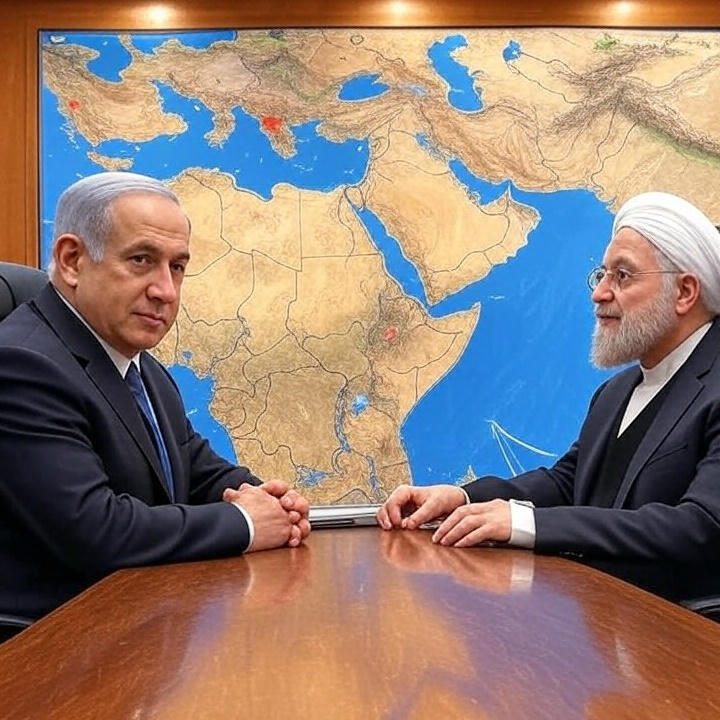
In June 2025, the Iran-Israel conflict 2025 escalated dramatically with Iran’s multi-warhead attack, a bold display of advanced missile technology that tested the resilience of Israel’s defense systems. Dubbed Operation True Promise III, Iran’s barrage of ballistic missiles, including hypersonic missiles like the Fattah-1 and MIRV-capable ballistic missiles, targeted key Israeli sites, including Tel Aviv and intelligence facilities. This blog examines how advanced missile tactics are testing Israel’s Iron Dome effectiveness, exposing vulnerabilities in its missile defense networks, and reshaping regional dynamics in a manner that draws in U.S. involvement via THAAD, signaling broader implications for Asia and global security.
The Anatomy of Iran’s Multi-Warhead Attack
Iran’s multi-warhead attack leveraged Multiple Independently Targetable Reentry Vehicles (MIRVs), a technology that allows a single missile to deploy multiple warheads, each targeting a different location. Unlike traditional ballistic missiles, MIRVs saturate defenses by overwhelming interceptors, as seen in Iran’s strikes on June 13–18, 2025. The attack also featured hypersonic missiles Iran developed, such as the Fattah-1 and Fattah-2, which travel at speeds exceeding Mach 5 and use erratic trajectories to evade detection. These missiles, launched from Tehran and other sites, struck civilian and military targets, including the Aman Intelligence Logistics Center near Tel Aviv and Soroka Hospital in Beersheba.
The Tehran missile strikes were a response to Israel’s Operation Rising Lion, which targeted Iran’s nuclear program facilities at Natanz and killed senior Iranian commanders. Iran’s Islamic Revolutionary Guard Corps (IRGC) claimed the attack used a novel method to confuse Israel’s air defense, causing interceptors to target each other, allowing missiles to penetrate. This escalation highlights the evolving threat of MIRV vs. hypersonic missiles, where MIRVs focus on volume and hypersonics on speed and maneuverability, posing distinct challenges for Israel’s defense systems.
Israel’s Missile Defense: Strengths and Vulnerabilities
Israel’s multilayered missile defense system, comprising the Iron Dome, David’s Sling, and Arrow 2/3 interceptors, is among the world’s most advanced. The Iron Dome effectiveness is well-documented against short-range rockets, with a 90% interception rate in past conflicts. However, its utility against hypersonic missiles and MIRV ballistic missiles is limited, as these weapons travel faster and higher, requiring long-range systems like Arrow.
During Iran’s attack, the Arrow system faced a shortage of interceptors, exacerbated by intense barrages that depleted stocks. Reports indicate Israel’s defenses intercepted 80–90% of the 400 missiles fired, but breakthroughs caused significant damage, killing at least 24 and wounding hundreds. The impact of Iran’s missile attack on Israel was evident in damaged infrastructure, including a Haifa oil refinery and the Weizmann Institute, underscoring vulnerabilities in densely populated areas like Gush Dan.
The Israel air defense system’s reliance on costly interceptors (e.g., $2 million per Arrow missile) raises sustainability concerns. A prolonged conflict could exhaust Israel’s reserves, especially without US involvement via THAAD, which supplemented defenses but strained US-Israel coordination. The attack exposed a critical weakness: while Israel achieved air superiority over Tehran, its ground-based defenses struggled against Iran’s advanced missile tactics.
Geopolitical Implications for the Iran-Israel Conflict
The Iran-Israel conflict 2025 is rooted in Iran’s nuclear program ambitions and Israel’s preemptive strikes to prevent a nuclear-armed Iran. Israel’s Operation Rising Lion damaged Natanz’s uranium enrichment halls, delaying Iran’s nuclear timeline, but Iran’s retaliatory multi-warhead attack signaled its resolve to counter Israel’s aggression. The conflict’s escalation has drawn international attention, with President Trump navigating a delicate balance between supporting Israel and avoiding direct US military involvement.
The Iran-Israel conflict’s impact on Asia is significant, particularly for countries like Nepal, where telecom operators like Nepal Telecom could explore 5G spectrum policies to support defense technologies inspired by Israel’s systems. Asia’s energy markets also face risks, as Iran’s strikes on Israeli energy targets and Israel’s retaliation against Iran’s South Pars gas field threaten global oil and gas supplies, affecting Asian economies. Nepal’s foreign policy students and experts should note how regional conflicts influence telecom and energy strategies.
Iran’s use of hypersonic missiles and MIRVs has reshaped deterrence dynamics. The Fattah-1 hypersonic missile, with its hypersonic glide vehicle (HGV), challenges traditional missile defense paradigms, forcing Israel to invest in next-generation systems like the Iron Beam laser. Meanwhile, Iran’s depleted missile stockpile (estimated at 750–1,000 long-range missiles, with 370 fired) suggests a potential weakening of its offensive capabilities, though underground facilities complicate Israel’s efforts to neutralize the threat.
Strategic Lessons for Israel’s Defense
The multi-warhead attack underscores the need for Israel to enhance its missile defense resilience. Key lessons include:
- Interceptor Stockpiles: Israel must increase Arrow and David’s Sling interceptor production to withstand prolonged barrages.
- Counter-Hypersonic Tech: Developing sensors and interceptors for hypersonic missiles that Iran deploys is critical, given their speed and maneuverability.
- Cost Efficiency: The high cost of interceptors necessitates cheaper alternatives like the Iron Beam, which could reduce interception costs to dollars per shot.
- International Support: Strengthening US involvement via THAAD and intelligence-sharing is vital, though political tensions may complicate coordination.
- Urban Protection: Relocating critical infrastructure from vulnerable areas like the Gush Dan could mitigate the impact of Iran’s missile attack on Israel.
For foreign policy experts, the attack highlights the interplay of technology and geopolitics. Israel’s success in degrading Iran’s air defenses and missile launchers (one-third destroyed) demonstrates the value of preemptive strikes, but Iran’s ability to penetrate Israel’s air defense with Tehran missile strikes warns against overconfidence.
Broader Implications for Global Security
The Iran-Israel conflict in 2025 has global ramifications. The Iran nuclear program remains a flashpoint, with Israel’s strikes delaying but not eliminating the threat. Iran’s missile advancements, particularly MIRV vs. hypersonic missiles, set a precedent for other nations, potentially sparking a regional arms race.
For journalists and bloggers, the conflict offers a lens to explore how Operation True Promise III reshapes Middle East dynamics. Iran’s targeting of civilian areas, including hospitals, has drawn accusations of war crimes, while Israel’s strikes on Iran’s energy infrastructure raise ethical questions. Foreign policy lecturers can use this case to teach about deterrence, escalation, and the role of technology in modern warfare.
The Iran-Israel conflict’s impact on Asia extends to security policies, as countries like India and China monitor missile technology developments. Nepal Telecom’s interest in 5G spectrum policies could align with defense applications, such as real-time missile tracking, inspired by Israel’s systems. This intersection of telecom and defense is a fertile area for research and policy analysis.
Navigating a New Era of Missile Warfare
Iran’s multi-warhead attack in Operation True Promise III has tested Israel’s defense systems like never before, exposing both their strengths and vulnerabilities. The interplay of hypersonic missiles Iran developed and MIRV ballistic missiles challenges Israel’s missile defense, demanding innovation and resilience. The Iran-Israel conflict 2025 has far-reaching implications, from delaying Iran’s nuclear program to disrupting Asian energy markets and inspiring telecom-defense synergies in Nepal.
For foreign policy students, teachers, lecturers, journalists, experts, and bloggers, this conflict offers a rich case study in missile technology, deterrence, and global security. As Israel and Iran navigate this volatile landscape, the world watches, grappling with the realities of a new era in warfare. Share your thoughts below: How can Israel’s air defense adapt to Tehran missile strikes, and what lessons can Asia learn from this conflict?
